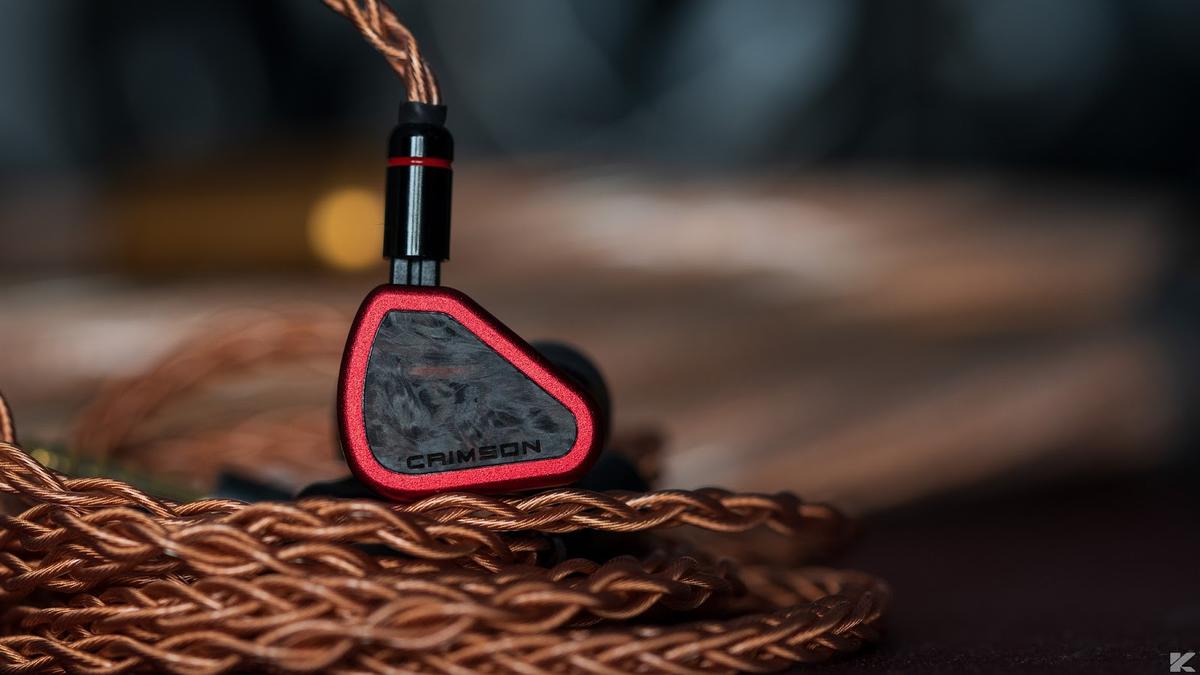Class-leading dynamism paired with an unassuming driver configuration.
- High-quality stock ear tips and cable
- Superb coherence for a multi-BA config
- Breathtaking dynamics
- Exceptional staging and imaging
- Highly resolving throughout the frequency range
- Difficult to drive
- Extremely source and tip-dependent sound
- Sealed design can lead to discomfort due to pressure buildup
- Upper-treble can be bothersome in some tracks
Certain stigmas are attached to the good ol’ BA driver. For example, “they cannot produce physicality in bass frequencies,” “they tend to distort at very high volumes,” and “the timbre is far from perfect” – some say “plasticky” even.
While I could never figure out the plasticky bit about BA drivers (a term that has confounded me when describing sound), I have experienced and acknowledged the rest over time.
Typical BA drivers cannot push the same amount of air as their dynamic counterparts, and the distortion leads to timbral issues heard at the extremities.
Or so I thought.
The Symphonium Crimson are a pair of all-BA IEMs that shatter those expectations and prejudices. The bass slams hard, as hard as some of the best dynamic driver IEMs out there. The sound is coherent and devoid of timbral mismatch. And even at uncomfortably loud SPLs, the drivers don’t break a sweat.
So, are the Crimson the new benchmarks in the kilo-buck range? We will know by the end of this review.
One Minute Review Video
Design and Build
The Symphonium Crimson have an understated yet classy design.
The 6-series aluminum shell harkens back to the days of the older iPhones that used the same material for extra rigidity. The inner shell has a matte black finish, while the face has a forged carbon plate with a bright red aluminum surround.
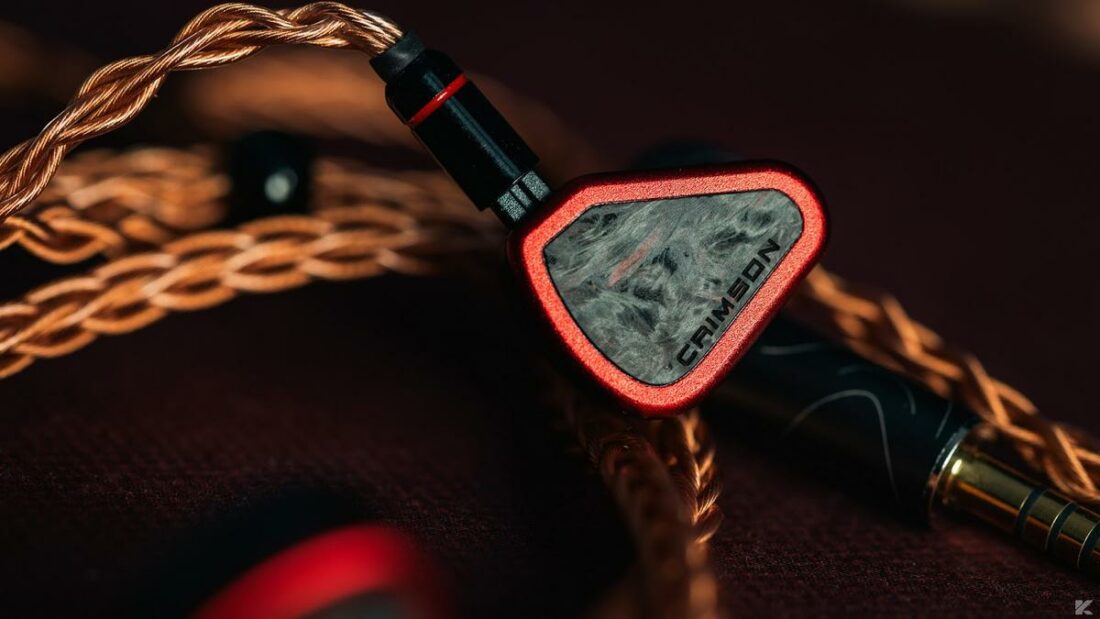
Upon first glance, the Crimson’s faceplate design is not the most striking, but as you look closer, the depth becomes apparent. The gradient and patterns change with subtle shifts in lighting, adding more complexity to the overall aesthetics.
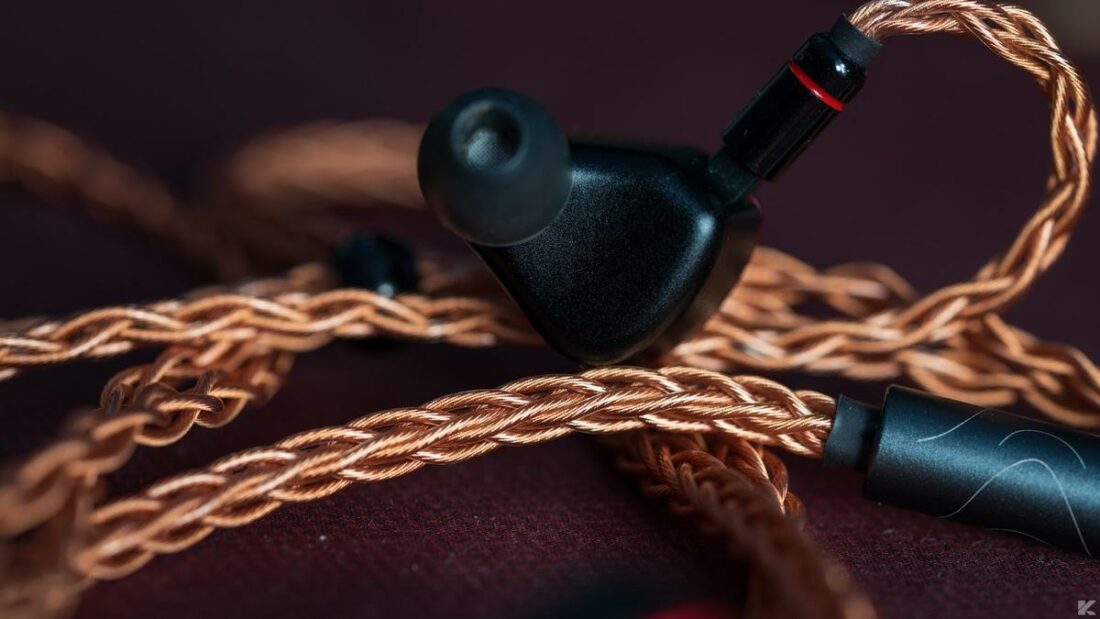
The 2-pin ports are slightly recessed into the shells and use a spring-loaded mechanism.
Overall, the Crimson have an excellent build befitting of a TOTL flagship, and I cannot find any notable flaw.
Cable
I often gravitate towards “upgrade” cables when trying out TOTL IEMs, but the Crimson are an exception. I find the stock cable already so good that further investment in aftermarket cables seems redundant.
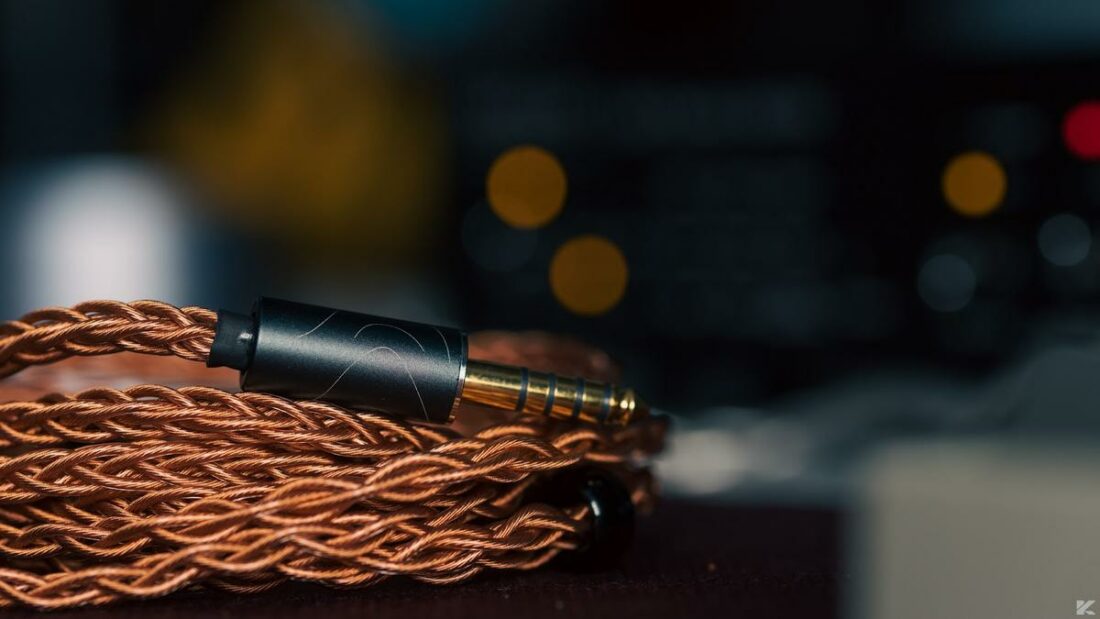
The stock cable is excellent, especially in the 8-wire variant.
The Altalune Novaron cable for the Crimson is a custom variant that is not directly available for purchase. However, you can choose the 8-wire version during the purchase process (for extra cost). A nice perk is the swappable termination, which allows quick swapping between single-ended and balanced jacks.
I received the unit with the 8-wire cable bundled. In terms of measurable difference, it has a lower impedance than the 4-wire variant (0.12 ohms vs 0.2 ohms).
Comfort
The Crimson are absolutely fine in nozzle length, thickness, and overall fit. It’s the ventless design that will make or break things for you.
I had difficulty taking a high-speed train journey while wearing the Crimson. As the train passed under tunnels, the pressure build-up was so intense that I had to yank them off.
The lack of a vent is a potential deal-breaker and can lead to pressure buildup in the ear canals.
Admittedly, this is an edge-case and somewhat extreme example but be warned if you plan to use the Crimson on a flight or long-distance train journey.
Other than that, I got used to their feel quickly, and the pressure buildup was mild enough not to cause discomfort, even during long listening sessions. As a plus, the isolation is excellent, as the lack of venting effectively blocks outside noise.
Under the Hood
The Symphonium Crimson utilize 4 BA drivers in a 4-way crossover design.
Let’s start with a slight digression.
There was a small brouhaha over at head-fi when the Crimson was first launched centered around the lack of information regarding the driver config. Symphonium’s intention was for people to hear the IEMs without a preconceived notion or bias, and I can imagine why (“all-BA can’t do bass well,” “they all sound plasticky,”… you know the drill).
Unfortunately, the result was confusion.
Getting back on topic, including a 4-way crossover indicates that each of the four drivers covers a specific frequency range. Reportedly, the drivers use a mixture of tube and acoustic chamber-based tuning methods, but once again – Symphoniuym keeps the exact acoustic structure hidden.
Phase issues are avoided using Symphonium’s proprietary PHAT technology, while FLAT tech ensures a flat impedance curve irrespective of the output impedance of the source gear.
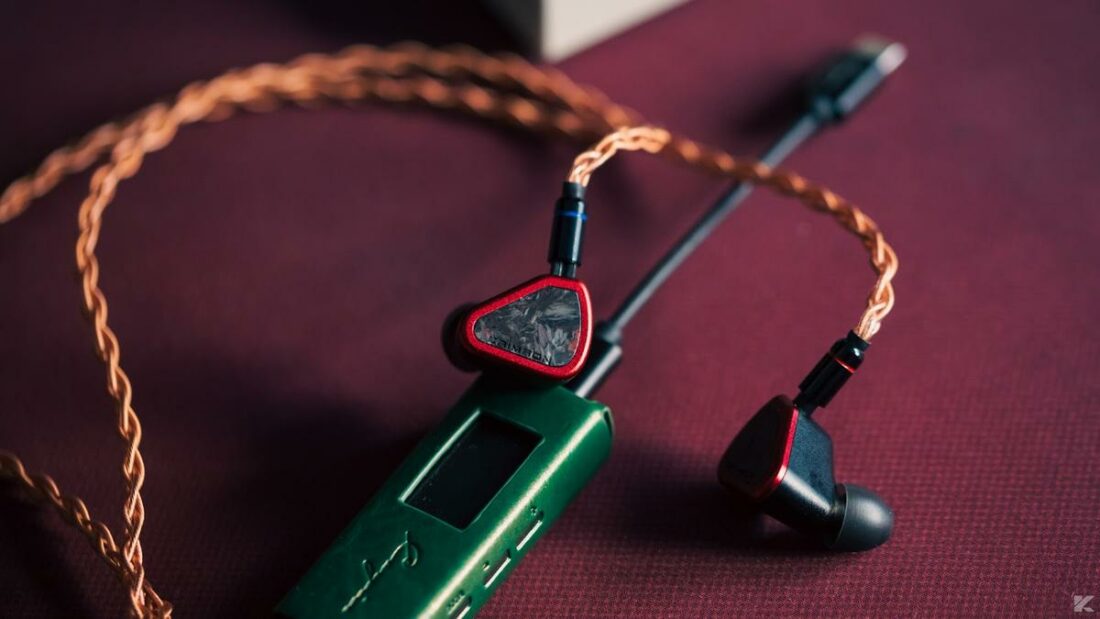
While the exact working principles of these technologies are hidden, they work exceedingly well in practice. The Crimson have a mostly flat impedance curve, and their exceptional imaging and coherence attest to the lack of phase issues.
How Do the Symphonium Crimson Sound?
The general tuning of the Symphonium Crimson is balanced with sub-bass boost.
However, it’s a gross generalization to merely distill the Crimson’s tuning into a single adjective or two. The overall presentation is highly engaging and adept at reproducing the energy of modern tracks.
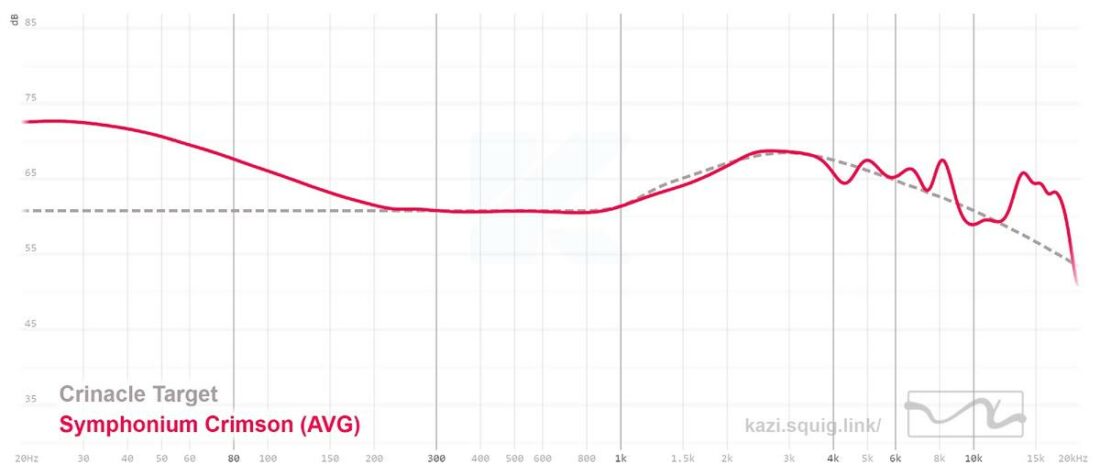
Bass
Throw away all your preconceptions about BA bass – the Crimson produce thunderous lows.
Let’s get my nitpick out of the way first: I would prefer a smidgen more mid-bass. It’s not anemic sounding by any stretch, but grand pianos could do with a bit more weight, for example.
Other than that? Perfect bass, or at least for those not obsessed with outlandish sub-bass boost. Despite the <10dB sub-bass shelf, the tuning complements electronic music and other bass-heavy genres.
The underlying bass groove in Isaac Delusion’s Midnight Sun displays even the subtlest nuances. It’s not just a hazy, dense rumble – there is texture and body.
To use the tired cliche of “hearing new things in familiar tracks,” Porcupine Tree’s Heartattack in a Layby has a faint sub-bass rumble that fades in and out at the beginning. I never noticed this until I heard the track on Crimson.
Bass having both physicality and details is a rare feat indeed, and the Crimson manage it with aplomb.
Midrange
Smooth is the operative word here. No shout or shrillness or abrupt upper-mid peaks. Unless you are absolutely averse to upper-mid presence, the Crimson will sound “balanced” throughout the midrange.
The lower-mids do not sound anemic or thin, but the extra sub-bass can cast a haze over things in heavier tracks with growling, guttural vocals. Female vocals do not suffer such issues and cut through the mix well.
The midrange tuning is safe.
Acoustic guitars have a sharp leading edge, but the timbre is slightly off at times, as can be heard on Damien Rice’s Cannonball. Certain headphones and IEMs can have a more organic rendition of this track, another nitpick I have about the Crimson’s mids.
Treble
The upper-treble on the Crimson can be divisive.
On the plus side, there is exceptional extension around the extreme end of the treble region. However, this can come across as too boosted, resulting in somewhat “sizzly” cymbals and hi-hats. The added airiness can also cause listening fatigue if you are especially sensitive in that region.
Then again, this focus on airiness contributes to the incisive nature of these IEMs, so it’s not a bad trade-off.
Other than that, there is no sibilance in the treble region, nor are there problematic presence region peaks between 5 – 7 kHz.
Technicalities
The Crimson are exceptional in terms of technical prowess.
Overall, resolution is class-leading in terms of low-level detail rendition and spatial qualities. Due to the extremely tall soundstage perception, the entire presentation of the Crimson can sound uncanny.
Things are often pushed to the back of the ear, a phenomenon unnoticed with other IEMs. Imaging, as a result, can feel a bit different. Things that are usually on the extreme right can sound somewhat pushed “downwards” to the right.
This is not the case for every track, though. This unique staging makes it worthwhile to revisit old tracks as they are presented anew.
In The Bleachers’ Alma Mater, details pop up all around you. Sonic cues can appear very near or almost at shoulder length. The macrodynamic punch can be just as impressive.
In The Eagle’s Hotel California (Hell Freezes Over version), the conga hits begin around the 0:30 second mark. The macrodynamic punch is breathtaking in this segment, as I was caught off-guard when first listening to this track on the Crimson.
Imaging is another strong area of the Crimson, and there are no apparent gaps in instrument placement in both cardinal and ordinal directions.
The one area where the Crimson may fall short of their peers is in microdynamics, which isn’t class-leading. Nonetheless, it is a tremendous feat to have ticked so many boxes with “only” four drivers.
Pairing Notes
The Crimson are exceptionally hard to drive at 106 dB/Vrms into 6 ohms. Most portable sources choke when trying to deliver current into such low-impedance loads. There are exceptions, of course, but the Crimson will bring most dongles to its knees, and you won’t hear their full potential.
The Crimson can sound bland and almost boring if you cannot power them properly.
Cayin’s RU7 is a great dongle, currently my favorite overall, and the one I use with most IEMs on the go. However, the Crimson did not pair well with it, lacking in dynamics and not showing the subtle details in bass and treble they are capable of.
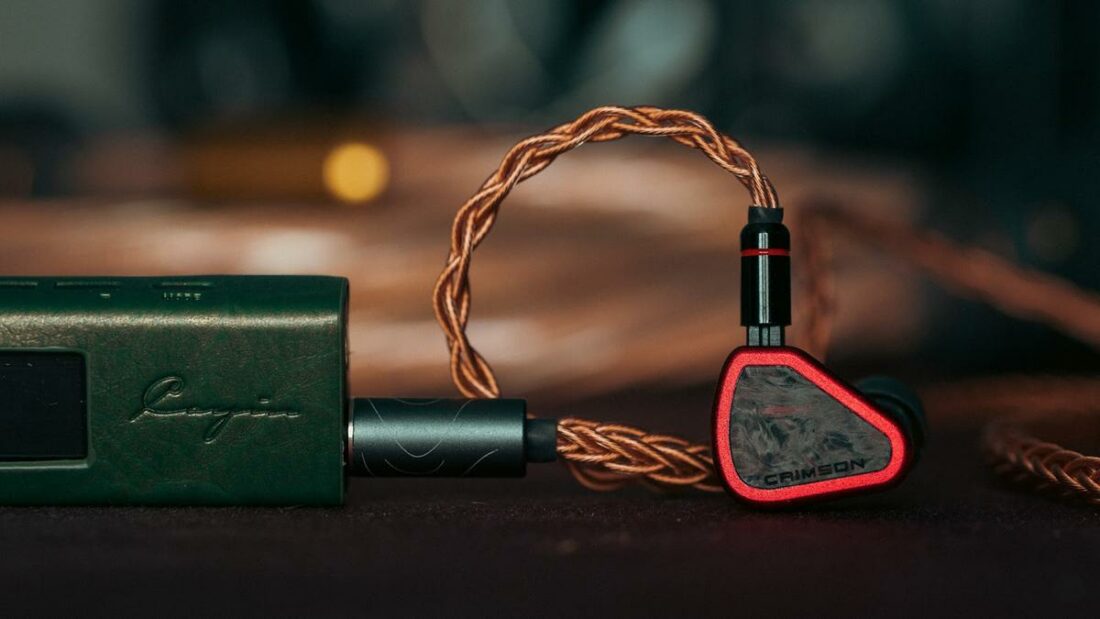
So I switched to my endgame stack: the Lotoo PAW Gold Touch as the DAC and the Cayin C9 as the amp, with the C9 set to class-A and high gain mode. Now, there was enough headroom to get the Crimson extremely loud, but the dynamics were still a bit meek.
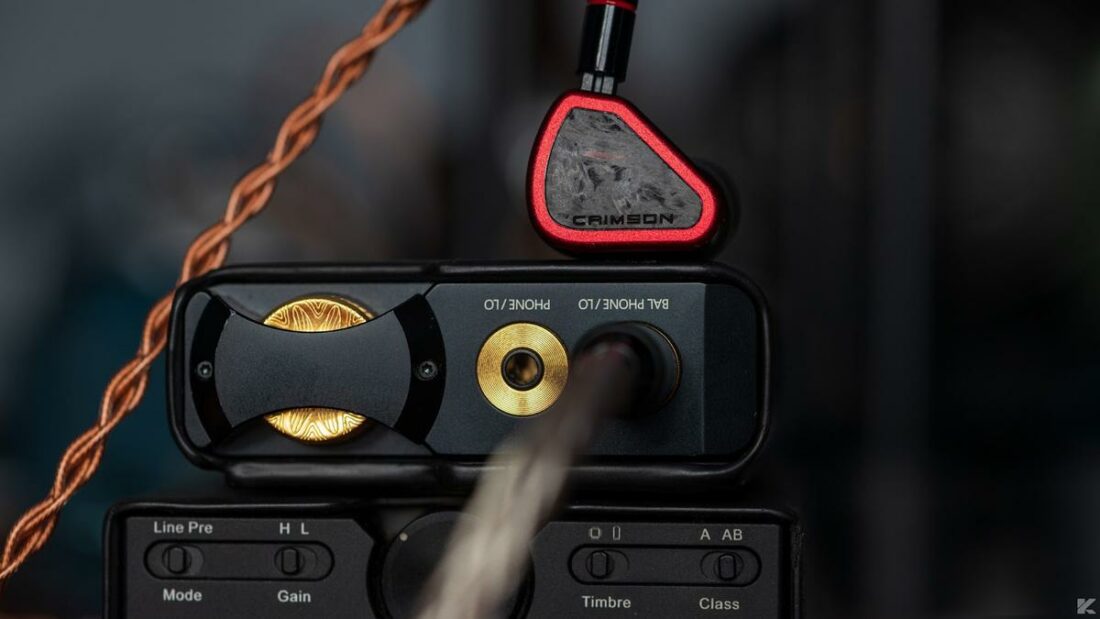
Finally, I tried them on the Questyle CMA Twelve Master with the gain set to high and high bias turned on – the same setting I use to power the likes of the Hifiman HE-6se V2, as the current mode amp section is perfect for power-hungry planars.
This is where the Crimson sound their absolute best. Resolution, speed, clarity, dynamics – all the good stuff. Frankly, I could listen to them all day on this source and not feel the least bit bored, but unfortunately, it’s from a stationary desk source.
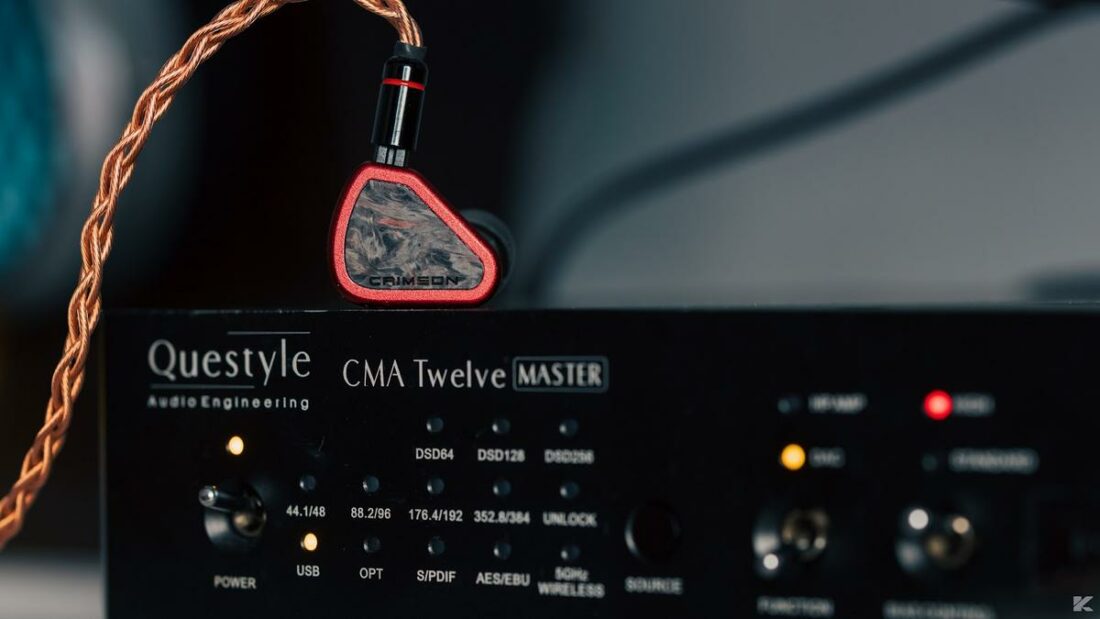
And that’s the biggest bummer: the Crimson sound their best on desktop sources, but you’ll likely want to carry your IEMs around and listen to them on portable or transportable sources. Ah well.
Comparisons
Symphonium Crimson vs Sennheiser IE 900
The Sennheiser IE 900 are another example of driver minimalism, with a single, 7mm dynamic driver handling the entire frequency range and doing a great job. Both the IE 900 and the Crimson have excellent treble extension, but their midrange tuning is almost the opposite.
The IE 900 have recessed upper-mids that push the vocals far away, resulting in a sense of widened stage at the cost of vocal intimacy. The Crimson do the opposite and push vocals relatively more forward.
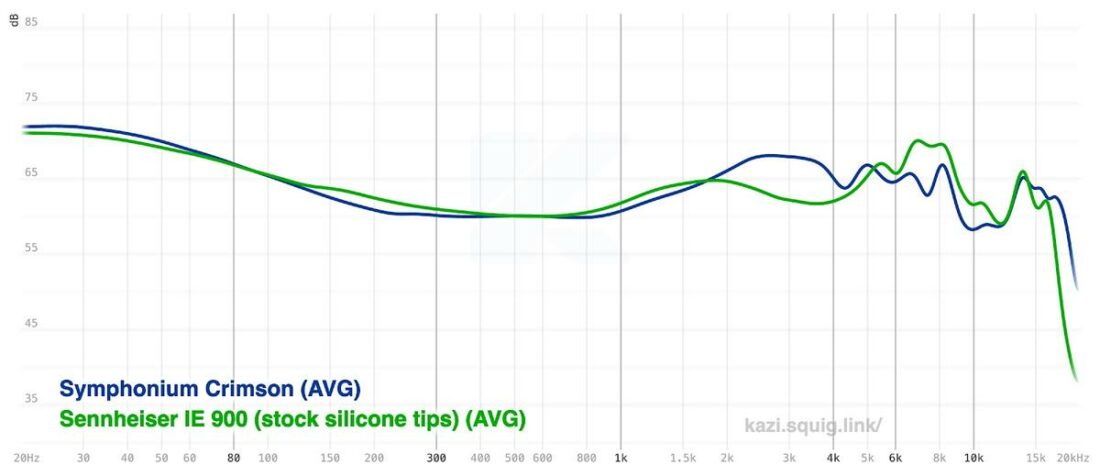
Treble tuning is also a bit different, with the IE 900 having more pronounced mid-treble emphasis, which somehow balances out the upper-treble boost up top.
Bass response on both IEMs is extraordinary, with the IE 900 having better mid-bass punch while Crimson have better sub-bass rumble. Male vocals and grand pianos have better heft on the IE 900, while female vocals have more energy on the Crimson.
Finally, both of these IEMs are technically supreme performers, with the IE 900 having better stage width while the stage depth being more convincing on the Crimson. The Crimson win in terms of macrodynamics, while IE 900 lead the pack in terms of microdynamics.
Symphonium Crimson vs FiR Audio Radon 6
The FiR Radon 6 are more expensive than the Crimson and boast a six-drive hybrid configuration: 1DD, 4 BA, and 1 EST (a bit odd as Sonion ESTs come in pairs).
The tuning is quite different between these IEMs, as the RN6 focus heavily on their sub-bass response. The sub-bass on the RN6 have unmatched physicality, sometimes a bit too much for me.
The bass driver on the RN6 interacts via a combination of air and bone conduction. The latter is something I am not used to, so I can find the sensation overwhelming. When it works, though, it’s one of the most satisfying basshead experiences you can get.
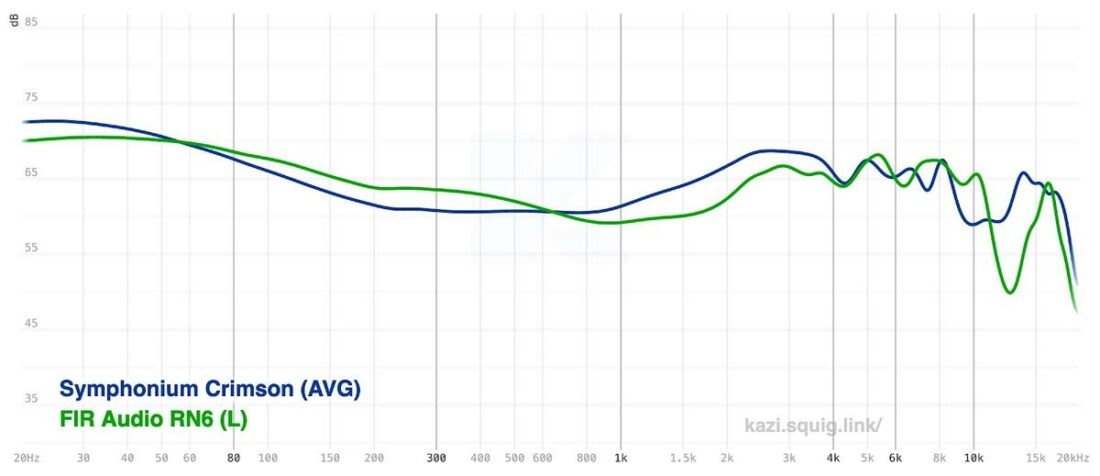
The treble on the RN6 is less forward, but the upper-mids can sometimes sound recessed. Staging is wider on the RN6, while the stage depth, again, goes to Crimson. Finally, the macrodynamic punch is more physical on the RN6, while Crimson win in terms of speed.
Overall, the Crimson compete favorably with the RN6 in areas other than the sheer bass physicality, which is the calling card of RN6. For the Crimson’s significantly lower price tag, it’s quite an achievement.
Where to Buy
Who Should Buy This?
Those who want to unearth minute details in every track with class-leading dynamics and separation and do not mind a ventless design and the high current requirements need to check out the Symphonium Crimson.
Final Thoughts
I will be frank. Continuous exposure to TOTL gear has rendered me somewhat numb to the latest and the greatest. Most new releases seem like a sidegrade even after multiple auditions, and the relentless price hike for subtle (if any) improvements further diffuses my enthusiasm.
The Crimson are different. I received them as loaners and plan to buy a pair soon. They complement my existing arsenal of IEMs so well that it’s almost a no-brainer. Most importantly, the price is fair, even undercutting the competition in terms of raw performance.
However, the source requirements give me pause. I hope Symphonium finds a solution with a more sensitive driver arrangement in upcoming releases (where the impedance is higher). The Crimson require desktop gear to reach their full potential. I have heard them at their best, and there is no going back.
If you own the appropriate source and want to hear your tracks with a delightfully different presentation – the Crimson are a must-buy. At least give them an audition; it can’t hurt much (other than your wallet, I guess).
Company Overview
Established in 2016 and based in Singapore, Symphonium Audio is a boutique manufacturer specializing in high-end IEMs. The brand specializes in all-BA IEMs, incorporating proprietary technologies to differentiate from the mainstream market.
What’s in the Box?
- Symphonium Crimson IEMs
- Aluminum carrying case
- 4-core or 8-core cable with replaceable termination
- 4 pairs of Azla Sedna Earfit Regular tips
- 4 pairs of Divinus Velvet tips
Technical Specifications
- Form: IEMs
- Driver: 4 x BA driver
- Impedance (Ohm): 6 ohms
- Sensitivity (dB): 84 dB/mW
- Weight (g): 7g
- Frequency Response (Hz): 10Hz – 24kHz
- Removable Cable: Y
- Source Jack: 3.5mm, 4.4mm
- Cup/Shell Jack: 2-pin
